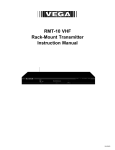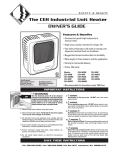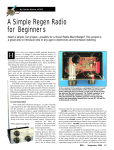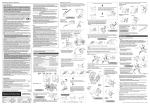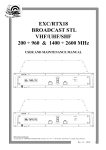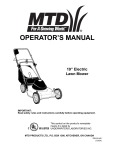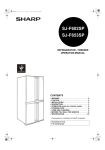Download Cerwin-Vega T-680 Microphone User Manual
Transcript
Vega T-680 Series UHF PRO-PLUS Wireless Microphone Owner's Manual T-689 T-682 T-687 T-688 099-0054B 2 T-680 Series A Word to Vega Users In selecting Vega wireless microphones, you are in the company of audio professionals worldwide. Leadership for over 30 years has made “Vega” synonymous with wireless microphones. Vega equipment provides superb sound quality, outstanding performance, and durability needed for years of successful operation. Unpacking Unpack and save cartons for storage or reshipping. Verify the equipment shown as “shipped” has been received in good condition. If, for any reason, you do not find the equipment to be completely satisfactory, please immediately contact your Vega dealer or the Vega factory. Should service ever be required, remember your authorized Vega service dealer knows your equipment best. They have the training and test equipment necessary to restore your equipment to its peak performance. Please feel free to contact either your authorized Vega dealer or the Vega factory for information or assistance at any time. Quick Start See below for a description of transmitter controls and the next page for setup. If this is the first time you are setting up a wireless system, carefully read all manuals furnished with your equipment to ensure optimal performance. Windscreen Microphone Switch: Turns mic audio on\off without turning transmitter off. Audio is on when switch is pushed toward the dot. Mic Gain Control: Set so corresponding receiver's VU meter nominally reads “0” on audio peaks. Power Switch: Turns power on and off. Power is on when switch is pushed toward the dot. Audio Peak LED: Flashes on audio peaks; indicates audio limiter has been activated due to high sound levels. Wireless-Microphones 1 Unlatch cover and insert a 9-volt battery. Slide 9-volt battery into compartment with the plus “+” terminal as shown above. Slide cover back on. 3 In the area covered by the wireless system, verify the receiver is receiving by observing its indicators (see receiver instructions for details). 5 Adjust mixer/preamp/amplifier to its normal setting. Speak into mic. If necessary, adjust receiver's audio output level until wireless system volume matches wired system volume (see receiver instructions for details). 3 2 Turn the transmitter Power “P” on and Microphone “M” on by sliding the switches toward the dots. 4 With a small screwdriver, adjust transmitter mic level so the receiver's “AUDIO LEVEL” LED flashes only when speaking very loudly. If it flashes frequently, turn it counterclockwise. If it doesn't flash at all, turn it clockwise. 6 “Walk” the coverage area to check for problems. If there is a problem, check mic batteries (fresh?); ensure antennas aren't touching each other or any metal objects. Path between transmitter and receiver must be clear for proper operation. 4 T-680 Series Compatibility T-680 Series mics are designed to work with Vega's Model 662 Series receivers. T680s are not necessarily compatible with other receivers, especially if not purchased together. System receivers must use DYNEX®III audio processing and use precisely the same frequencies as the transmitters. The transmitters are not compatible with other manufacturers' receivers. T-680 Series mics work in the 494 to 608 MHz and 614 to 806 MHz UHF range. The exact frequency is marked on the data label inside the transmitter's battery compartment. If the transmitter and receiver frequencies are not precisely the same, the frequency of one of the units must be changed. It's advisable to return both units to the factory or authorized service location when changing frequencies, to ensure the best results. Because of the very high performance of these units and the specialized test equipment required to adjust them properly, users should not try to change frequency themselves. If two or more systems are used at the same location, proper frequency selection and spacing are required to avoid possible interference. Vega offers a free frequency-coordination service for purchasers of its equipment. Frequencies are selected by computer to avoid any possible interference from other wireless systems and broadcast stations. To take advantage of this free service, contact the Vega factory or your local sales representative (phone number on last page of this manual). The T-680 Series professional handheld transmitters are self-contained units and require only a battery and a compatible receiver for operation. Individual models in the T-680 Series each use different types of microphone elements, leading to some differences in physical appearance between the various models. However, all transmitters in this series are functionally equivalent, and the operation instructions below and other information in this manual are applicable to all models. Because of the acoustic characteristics of the various types of microphone elements, individual models in this series may sound significantly different from other models. These differences are entirely due to the microphone element; all models offer identical performance, otherwise. Wireless-Microphones Operating Instructions (1) Verify that the associated wireless-microphone receiver is on the exact same frequency as the T-680 Series transmitter to be used. (2) Set up, adjust, and connect the receiver as described in its instruction manual. (3) Verify that the transmitter's battery is fresh. (4) Turn on the transmitter via the switch on the bottom (toward the dot). The LED indicator should flash briefly upon turn-on; this indicates that the battery is installed properly. NOTE: The LED does not provide an indication of battery condition. If there is any question as to the condition of the battery, it should be replaced prior to use of the transmitter. (5) Turn “on” the microphone in the transmitter via the switch on the bottom of the unit (toward the dot). Make an initial adjustment of the microphone gain control of about one-quarter turn from the minimum (fully counterclockwise) position. (6) With the receiver and transmitter on, the “SQUELCH” indicators on the receiver should be illuminated. Observe the RF-level meter (or bargraph) on the receiver. If the meter does not read well above midscale when the transmitter is within a clear 50-foot radius of the receiver, difficulties are indicated (refer to section “In Case of Difficulty”). (7) Speak into the microphone at normal voice level. The audio meter on the associated receiver should indicate audio on voice peaks, and the audio should be audible on the associated monitoring equipment. The audio may also be monitored on headphones plugged into the receiver “monitor” jack. (8) Adjust the transmitter audio gain control, if necessary. When speaking or singing very loudly, the LED on the transmitter should flash “on” only on the very loudest voice peaks. This indicates that the transmitter is reaching the point where soft gain compression is occurring in the microphone preamplifier. If the system is correctly set up, the compression point will be reached only rarely. Internal adjustments are not required for normal operation. Only qualified experienced technicians should open the case. Unauthorized adjustments or repairs inside the equipment case can void your warranty and cause unnecessary repair cost. If you feel that internal adjustments or repairs are needed, we recommend you contact the factory or your nearest authorized service center. (10) “Walk” the coverage area to ensure that there are no areas of poor coverage. Signal “dropouts” (little or no signal in small areas) show up as a flickering of the “SQUELCH” indicator on the receiver and a brief “fizzing” sound in the audio (which may or may not be followed by a silent period due to squelched audio). The audio may be conveniently monitored with headphones plugged into the front-panel “MONITOR” jack on the receiver. If there is an area where a “dropout” occurs, the receiving antenna(s) can usually be repositioned to eliminate the problem. Frequently, a change of just a few inches in location will completely solve the problem. 5 6 T-680 Series Antennas The receiver antenna may be the most important single component in a wirelessmicrophone system. However, this is the item most often overlooked in setting up a system, and is frequently the cause of quite unnecessary problems. Proper placement of the receiving antenna(s) is vitally important in any wireless-microphone system. A whip antenna connected directly to the wireless receiver is adequate for many installations. This type of antenna is provided with the R-662 Series receivers. When the distance between the receiver and the transmitter is 100 to 200 feet (30-60 m) or less, and there is a clear, unobstructed line-of-sight path between the receiver and the transmitter, good results can usually be obtained. Optional Antennas If you wish to have the receiver in a location which does not have a clear line-ofsight path to the transmitter, another type of antenna will be needed. Vega offers magnet-mount 1/4-wave-whip and “ground-plane” antennas with an attached 15foot (4.6-m) cable, which may be used for this purpose. Two such antennas are required for use with diversity receivers. Other types of antennas may be needed for unusual applications, such as operating at extreme ranges of 500 feet (150 m) or more. Vega offers a high-gain log-periodic antenna that covers the complete operating-frequency range of the R-662 receiver. UHF TV antennas (with appropriate matching transformers) are often used for this purpose. A wide-bandwidth “corner reflector” antenna works well in this application. Wireless-Microphones UHF communications antennas are also sometimes used for specialized requirements. However, such antennas are usually narrow band and must be modified to function properly in the 494 to 608 MHz and 614 to 806 MHz ranges. Contact the Vega factory or your sales representative for assistance in selecting antennas for unusual applications. Antenna Placement No matter what type of antenna is used, care must be used in positioning and mounting. In all cases, a clear and unobstructed line-of-sight path between the receiving antenna and the transmitter is required. The receiving antenna may be concealed behind fabric, thin plastic, acoustic tile, and thin plywood without significantly affecting performance. However, close proximity to metallic objects such as furniture, lighting fixtures, scaffolding, electrical cables, metal structural members, aluminum window frames, and equipment cabinets must be avoided. Whip and dipole antennas require at least a 5-inch (0.13-m) minimum spacing from metal surfaces. Other types of antennas may require greater spacings. The radiation pattern of these antennas is much larger than the antenna itself. Consequently, even objects well off to one side of the line-of-sight path can distort the antenna pattern, affecting performance. Also often overlooked are the effects of using metal brackets for physical mounting of the receiving antenna. Vega's magnetic-mount and groundplane antennas are designed to mount on a flat metal plate and on an antenna mast, respectively, but many types of antennas are not. The manufacturer's recommendations should be followed when using Yagis and other types of specialized antennas. The use of long cables connecting the antenna to the receiver is strongly discouraged. At UHF frequencies, the signal loss in the cable rapidly builds up and can seriously degrade operating range. 7 8 T-680 Series In Case of Difficulty The majority of difficulties with Vega wireless mics are not due to equipment failure. Vega equipment is fully tested before leaving the factory. In most instances, problems are due to equipment application. The following paragraphs describe the most commonly encountered application problems. If you are having difficulties with Vega equipment, please review this information and take any necessary corrective action prior to returning the equipment for repair. Most users of Vega equipment enjoy years of troublefree operation. However, as with all electronic devices, problems might be encountered eventually. If you experience difficulty with your Vega wireless microphone within the first year of operation, it will be repaired under warranty (see below). Service for older units may also be obtained from Vega; contact the factory or your sales representative for information. General Contact the Vega factory or your sales representative prior to returning equipment for repair. Often, the problem can be resolved by phone, avoiding downtime for unnecessary returns. However, should repairs be necessary, Vega will promptly correct the problem and return the unit. Return both the transmitter and the receiver, to allow us to perform a complete checkout and test of the entire system. This can be especially helpful for elusive or intermittent problems Battery The most common problems with wireless-microphone systems are those related to the batteries. Vega recommends that only new, fresh Duracell MN1604 or “Eveready” Energizer No. 522 alkaline batteries be used. No other batteries tested by Vega provide equal life and reliability. Other batteries might work, but battery life probably will be short and current inadequate. Rechargeable batteries (“ni-cads”) are not recommended for use with T-680 transmitters. Their limited capacity does not provide adequate operating time. Exhausted batteries will cause numerous problems, including distortion, audible squeals and howls, poor range, and off-frequency operation. It is strongly recommended that the battery be checked prior to each use, and that it be replaced if there is any question about its condition. It is also good practice to try replacing the battery with a fresh unit in the event of any sort of problem with the system, because a low battery might affect system operation in subtle ways. Battery contacts must be clean and unbroken. Attempted forced reverse insertion of a battery is practically impossible, but the attempt will often damage the battery contacts. Some “9-volt” batteries sold are larger (or smaller) than standard and either might fail to work or might damage the contacts when inserted. Damage to the contacts usually requires a return to the factory or authorized service center. Wireless-Microphones 9 Interference Vega wireless-microphone systems have been specifically designed to reject interference. However, interfering signals might fall directly on the receiver frequency, making it impossible to avoid problems completely. As mentioned above, this can be a particular problem if the receiver audio is left open when the transmitter is turned off. Problems with RF noise sources (fluorescent lights, digital effects generators, industrial equipment, etc.) are quite rare. However, defective fluorescent lighting fixtures can generate astonishing amounts of RF energy. Usually, repairing the fixture will cure the problem, because normally functioning fixtures almost never cause trouble. Some digital audio and video signal-processing equipment and effects generators also can generate substantial amounts of broadband noise. When this situation exists, nothing can be done to the wireless equipment to correct the problem that will not seriously degrade performance. The receive antennas should be positioned away from these sources of RF noise to minimize the effect of this interference. Fortunately, this type of problem is surprisingly rare. A more serious problem is selection of wireless-microphone operating frequencies, which are inherently subject to interference due to intermodulation. Fortunately, a proper initial selection or changing frequencies will almost always correct any such problem. Vega offers a free computerized frequency-selection service to purchasers of our equipment. If the frequency of other wireless equipment to be used in a given area is known, interference-free frequencies can be chosen. However, if equipment is added later without frequency coordination, it is likely that an interference problem will exist. Should this occur, contact the Vega factory or your sales representative for assistance. Many individuals believe that only a few wireless systems may be used in an area. This is incorrect, because installations with a dozen or more wireless systems are not uncommon. However, careful frequency coordination is essential. Common Sources of Interference 10 T-680 Series Receiver Noise Vega wireless microphone receivers are designed to be extremely sensitive. Although high-performance squelch circuits are provided, it is not unusual for the receiver squelch to open and let through audio noise when the transmitter is off. This is usually due to spurious outputs from two-way radio transmitters, adjacent-channel leakage from TV transmitters, and, in some cases, RF noise from digital equipment such as audio and video effects generators, computers, and other industrial equipment that might be located near the antennas. When the wireless transmitter is “on,” this noise is suppressed and rarely causes any difficulties. However, if the audio channel is left “open” with the transmitter “off,” loud blasts of noise might occur. For this reason, it is advisable to “fade” the receiver audio when the transmitter is not in use. Changing the placement of the antennas and, in some extreme cases, changing the operating frequency might be necessary to minimize these problems. Antennas/Cables As noted in the section on antennas above, antenna placement and mounting are vitally important. Blocking the antenna with metallic objects reduces the signal level and might cut off the signal entirely (pattern “nulls”). If there is a coverage problem, try moving the receiving antenna, particularly if there are nearby metallic materials. Vega FaxBack Information including more detailed procedures, schematics, and other Vega products is available 24 hours per day from Vega's FaxBack system. Simply call (626) 444-2017 or 800-274-2017, then follow the voice instructions. Warranty (Limited) All Vega PRO PLUS wireless products are guaranteed against malfunction due to defects in materials and workmanship for one year, beginning at the date of original purchase. If such a malfunction occurs, the product will be repaired or replaced (at our option) without charge during the one-year period, if delivered to the Vega factory. Warranty does not extend to damage due to improper repairs, finish or appearance items, malfunction due to abuse or operation under other than the specified conditions, nor to incidental or consequential damages. Some states do not allow the exclusion or limitation of incidental or consequential damages, so the above limitation may not apply to you. This warranty gives the customer specific legal rights, and there may be other rights which vary from state to state. Vega authorized service centers enable Vega to give customers immediate service on repairs. These service centers are fully qualified and equipped to handle the servicing of Vega equipment, and turnaround time is excellent. To obtain the address of your nearest authorized warranty service center, contact your dealer or the factory. If you should require service, pack the equipment carefully and return it to the factory service center or the nearest authorized service center. Wireless-Microphones Important: Be sure the exact return address and a description of the symptoms are enclosed inside the package with your equipment. It's also advisable to return the transmitter and receiver for a full system performance test when practical. Factory Service Center: Vega 9900 E. Baldwin Place El Monte, CA 91731-2294 (626) 442-0782 Claims No liability will be accepted for damages directly or indirectly arising from the use of our materials or from any other causes. Our liability shall be expressly limited to replacement or repair of defective materials. 11 12 T-680 Series T-680 Series Transmitter Specifications Operating Frequency: Emission/Modulation: RF Frequency Stability: RF Output Power: Spurious Radiation: Audio Processor: Acoustic Input Range: Controls: Indicator: Modulation Limiting (Compressor): Antenna: 494-608, 614-806 MHz Direct FM, crystal controlled, 180KF3E; 75-kHz maximum deviation ±0.002% 150 mW, nominal or 40 mW nominal, depending on version 40 dB below carrier, minimum; typically 50 to 55 dB below carrier DYNEX®III At maximum gain typically 112 dB SPL for onset of compression; maximum acoustic input: 143 dB SPL Power on/off, microphone on/off, microphone gain Audio compression Per FCC requirements; “soft” compressor action, 25 dB range; typically system distortion is less than 0.4% at 25 dB compression Patented* Internal dipole Battery: 9-V alkaline, Duracell MN1604 recommended Length: Varies by model, from 9.85 in (25 cm) to 10.75 in (27.3 cm) Weight: Varies by model, from 9 oz (256 g) to 13.5 oz (385 g), including battery UHF PRO PLUS System Specifications with R-662A or R-662B receivers Working Range: 1,700 ft under good conditions; 500 ft or more under typical conditions with standard whip antennas Audio Frequency Response: Depends upon microphone element and electronics; 90 Hz to 15 kHz, ±1.5 dB, 120 Hz to 12 kHz, ±0.75 dB (units include highpass filter to minimize handling noise; extended low-frequency response available on special order) Total Harmonic Distortion: <0.25%, 400 Hz, nominal input level Intermodulation Distortion: <0.25% (SMPTE 60/7,000 Hz, 4:1) Ultimate S/N: Dynamic Range: * Microphone off: 101 dB (flat), minimum; 108 dB typical, A-weighted. Microphone on: varies by element type and gain setting, typically over 100 dB (A-weighted) at normal gain settings. Varies by element type and gain setting; typically over 100 dB; over 125 dB with gain adjustment Patent #4,344,184 issued August 10, 1982 www.vegawireless.com 9900 East Baldwin Place • El Monte, California 91731-2294 Telephone: (626) 442-0782 • Toll-Free: 800-877-1771 Fax: (626) 444-1342 • CompuServe: 73513,1417 FaxBack: (626) 444-2017 • Toll-Free FaxBack: 800-274-2017 Printed in U.S.A. ©April 2000 Vega












